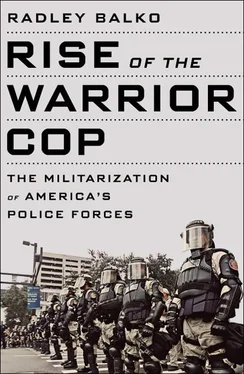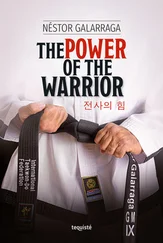“It’s SWAT,” I said.
“Oh, that’s pretty good. What’s it stand for?”
“Special Weapons Attack Teams.”
Davis blinked at me. “No.”
There was no way, he said dismissively, he would ever use the word “attack.” I went out, crestfallen, but a moment later I was back. “Special Weapons and Tactics,” I said. “Okay?”
“No problem. That’s fine,” Davis said. And that was how SWAT was born. 42
Gates still had some work ahead of him to win over his superiors. “That SWAT operates like a quasi-militaristic operation offended some of the brass,” he writes. 43So D-Platoon trained in secret on some city-owned farmland in the San Fernando Valley. They also began working directly with Marine units at Camp Pendleton in San Diego County, with some help from Universal Studios. The movie company let the abecedarian recruits hone their special forces skills on the replica storefronts, buildings, and houses on its back lot in Burbank. 44Within a couple of years, Gates’s SWAT team would forge its place in history during a televised shootout that made national news. But Gates clearly never got over the lack of support during the project’s early years. Of course, that reticence stemmed from a healthy appreciation for the Symbolic Third Amendment that Gates clearly didn’t share—or at least didn’t think was threatened by cops who trained with and operated like soldiers.
Despite [the new unit’s] record and reputation, officials balked at police using fully automatic weapons. The standard cry was, “Hey, the LAPD is supposed to be a civil police force. Their job is to relate to the community, not put on combat boots and assault the community.”
For years we tried to assure everyone that, yes, we are a civil police force. The people are the police, and the police are the people. And we hold to that.
Though at times, assault is not a dirty word. 45
For the types of situations Gates had in mind—the Watts riots, the Surry Street barricade, the Texas clock tower massacre—he was right. Assault wasn’t a dirty word. It was an appropriately swift, forceful response to defuse a violent situation.
As the domestic strife dragged on, other police departments began to see things the way Gates did. In March 1968, the Associated Press conducted a national survey and found that, “in city after city across America, the police are stockpiling armored vehicles, helicopters, and high-powered rifles… they are preparing for summer and the riots they hope will not occur.” In Gates’s Los Angeles, the AP reported, police watched a demonstration in which a twenty-ton armored personnel carrier crushed a barricade of abandoned cars. Tampa police chief James G. Littleton told the news agency that his department had “taken off the kid gloves.” He had just purchased 162 shotguns, 150 bayonets, 5 sniper rifles, 25 carbines and M-1 rifles, and 200 gas masks. Florida state attorney Paul Antineri told the AP that he had instructed police officers to “shoot to kill” if they spotted anyone committing or about to commit a felony. A spokesman for the New Jersey State Police told the AP, “We’re following through on the military concept in attacking this problem.” 46
This was an understandable response to the growing sense that American cities were spilling over with crime, violence, and rioting. And indeed, starting the month after the AP article was published, 1968 would unfold as one of the most turbulent years of the twentieth century. But when the riots, strife, and unrest finally died down, when the threat of chaos and lawlessness eventually grew remote, the weapons, heavy-duty vehicles, and militaristic culture stuck around. Gates’s original intent for the SWAT concept may have been appropriate, but as SWAT teams swelled in number, mission, and frequency of use over the next forty years, Gates not only never spoke out against the trend but took pride in it, and actively encouraged it.

BY THE MID-1960S, THE PIECES WERE FALLING INTO PLACE TO make disorder a national political issue. The crime rate was climbing. High-profile incidents like Whitman’s mass shooting had shocked the country. Riots had white America terrified of the cities. All that needed to happen was for a savvy politician to run with the issue.
In an April 1965 Gallup poll, more than half the country cited race relations as their number-one concern, the first time in eight months that a domestic issue topped the poll. 47Columnists and media outlets on the right were taking shots at the Supreme Court’s “criminal-friendly” decisions, as well as President Johnson’s failure to address crime with adequately tough measures. 48Johnson also watched the polls closely (the New York Times wrote in 1966 that “the President appears to retain an almost psychological need for public approval” 49) and was well aware that his approval ratings had started to sag—a long, slow decline starting in the spring of 1965. 50
Johnson attempted to co-opt some of his critics’ momentum by adopting the crime issue himself. He first turned to a Washington, DC, perennial: the blue ribbon commission. He announced the President’s Commission on Law Enforcement and Administration of Justice. His attorney general, Nicholas Katzenbach, would chair it. Its laughably lofty mission: to draw up “the blueprints that we need for effective action to banish crime.” 51The resulting report, The Challenge of Crime in a Free Society , included over two hundred recommendations to fight crime, from establishing a national phone number for emergencies—the precursor to 911—to decriminalizing drug abuse and public drunkenness. But Johnson’s critics seized on the more platitudinous and abstract recommendations: the commission asserted that ending poverty would be the single most important crime-fighting initiative and recommended minority outreach bureaus within major police departments, the establishment of multiple crime and justice research institutions, family planning assistance, recommitting to desegregation, funding for drug abuse treatment, and gun control. 52
To Johnson’s critics, this was just more leftist, mealymouthed academese. There was lots of government spending (the commission didn’t bother to estimate a price tag for its recommendations), plenty of lofty talk about social uplift, and hand-wringing about the influence on crime of environmental factors—all of which rather conveniently aligned with Johnson’s other domestic policies. But there was precious little in the way of taking it hard to the bad guys. For a war on crime, there wasn’t nearly enough fighting .
Johnson responded by making the federal government more proactive in fighting the drug trade. He created the first major federal agency specifically tasked with enforcing the federal drug laws. The Bureau of Narcotics and Dangerous Drugs (BNDD), which would later become the Drug Enforcement Administration (DEA), combined smaller agencies in the Treasury and the Health, Education, and Welfare Departments into one office that would operate within the Department of Justice. Johnson also expanded the Office of Law Enforcement Assistance into the Law Enforcement Assistance Administration (LEAA), 53the first federal agency created to stream federal funding, equipment, and technology directly to state and local law enforcement agencies. 54The United States had long taken a federalist approach to law enforcement. Except for offenses involving the mail, bank robbers, and crossing those state borders, the power to make crime policy had been reserved to the states. Johnson’s successors would quickly discover that introducing a funding spigot like LEAA, then threatening to pull it away, was an effective way to persuade local police agencies to adopt their preferred policies.
Читать дальше













